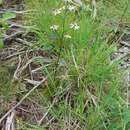Comments
(
英語
)
由eFloras提供
Symphyotrichum ciliolatum sporadically hybridizes with S. laeve var. laeve or var. geyeri in their areas of overlap, notably across the Canadian prairies and in south-central Ontario (Manitoulin Island, Bruce Peninsula). It also hybridizes with S. novibelgii var. novibelgii in the Gulf of St. Lawrence area [Symphyotrichum ×subgeminatum (Fernald) G. L. Nesom; syn. Aster subgeminatus (Fernald) B. Boivin]. Aster ciliolatus forma comatus Fernald is densely ciliolate along the midnerves and represents an extreme of the variation found in the species.
- 許可
- cc-by-nc-sa-3.0
- 版權
- Missouri Botanical Garden, 4344 Shaw Boulevard, St. Louis, MO, 63110 USA
Description
(
英語
)
由eFloras提供
Perennials, (10–)20–120 cm, colonial or cespitose; usually long-rhizomatous, sometimes with branched caudices. Stems 1–3+, erect (straight to ± flexuous), glabrate to sparsely hirsute or strigillose, especially distally. Leaves thin, margins coarsely, sharply serrate to crenate-serrate or serrulate, ciliate to scabrous, apices acute or acuminate, mucronulate, abaxial faces glabrate to sparsely hirsute, midveins usually densely hirsute, sometimes glabrous, adaxial glabrous or glabrate to scabrellous; basal usually withering by flowering (sometimes persistent on small plants), long-petiolate (petioles slightly winged, sheathing, ciliate), blades ovate, (24–)40–120(–270) × 15–70 mm, bases usually shallowly cordate, sometimes rounded; proximal cauline often withering by flowering, winged-petiolate, blades ovate to oblanceolate or lanceolate, (24–)60–150 × (10–)20–60 mm, reduced distally, bases subcordate to cuneate; distal sessile or sometimes subsessile (petioles widely-winged), blades lance-ovate to linear-lanceolate or linear, 18–75 × (2–)5–25 mm, bases cuneate, sometimes ± clasping, margins serrulate or entire. Heads [(6–)13–50(–100+)] in open, paniculiform arrays, branches ascending. Peduncles 0.2–1.5+ cm, unequal, reduced distally, ± hirsutulous, bracts 0–4, subulate or linear. Involucres campanulate, (4–)5–6.5 mm. Phyllaries in 4–5 series, narrowly oblong-lanceolate to oblong-oblanceolate or linear-oblanceolate (innermost), ± unequal, bases indurate 1 / 3 – 2 / 3 , margins narrowly scarious, erose, hyaline or infrequently purplish, sparsely ciliolate, green zones lanceolate to linear-lanceolate or linear, apices acuminate to long-acuminate, faces glabrous. Ray florets (12–)14–20; corollas pale to deep blue or bluish purple, laminae (8.3–)10–15 × 1–2.3 mm. Disc florets 14–25(–29); corollas yellow becoming reddish purple, 4.3–6.4 mm, tubes shorter than funnelform throats, lobes narrowly triangular, 0.5–1.1 mm. Cypselae yellowish white, obovoid, compressed, 1–2 mm, 5–6-nerved, faces glabrate to sparsely strigillose; pappi white to pinkish, 3–6 mm. 2n = 48.
- 許可
- cc-by-nc-sa-3.0
- 版權
- Missouri Botanical Garden, 4344 Shaw Boulevard, St. Louis, MO, 63110 USA
Synonym
(
英語
)
由eFloras提供
Aster ciliolatus Lindley in W. J. Hooker, Fl. Bor.-Amer. 2: 9. 1834; A. ciliolatus var. comatus (Fernald) A. G. Jones; A. lindleyanus Torrey & A. Gray; A. wilsonii Rydberg
- 許可
- cc-by-nc-sa-3.0
- 版權
- Missouri Botanical Garden, 4344 Shaw Boulevard, St. Louis, MO, 63110 USA
Symphyotrichum ciliolatum: Brief Summary
(
英語
)
由wikipedia EN提供
Symphyotrichum ciliolatum (formerly Aster ciliolatus), commonly known as Lindley's aster and fringed blue aster, is a perennial herb native to Canada and the northern United States. It is also known as ciliolate wood aster and northern heart-leaved aster. The common name Lindley's aster honours John Lindley who first described the species in 1834.

